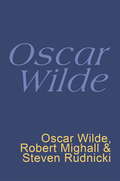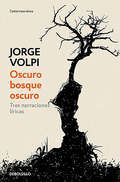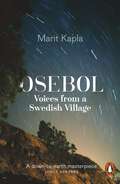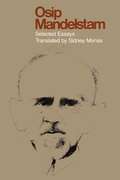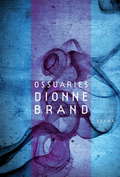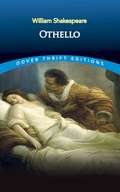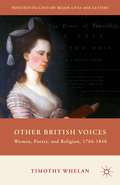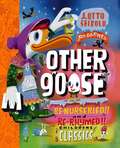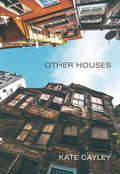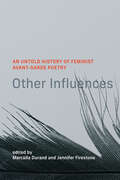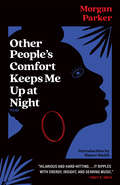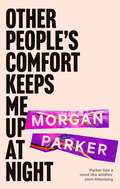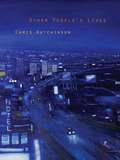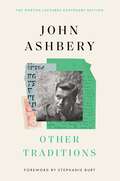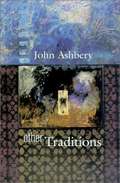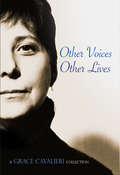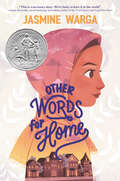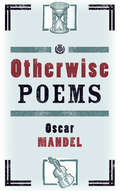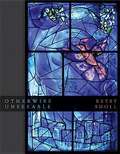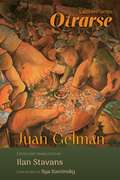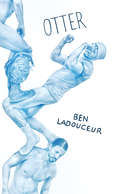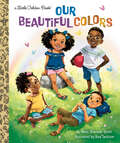- Table View
- List View
Oscar Wilde: Everyman Poetry
by Oscar WildeRenowned for his wicked wit and bons mots, Wilde also had a deep understanding of the human condition - as revealed with moving simplicity in THE BALLARD OF READING GOAL.
Oscar Wilde: Everyman's Poetry (Everyman Poetry Ser. #No.10)
by Oscar Wilde Robert MignallRenowned for his wicked wit and bons mots, Wilde also had a deep understanding of the human condition - as revealed with moving simplicity in THE BALLARD OF READING GOAL.
Oscuro bosque oscuro
by Jorge Volpi"Si sólo sobreviviera uno de mis libros, querría que fuera Oscuro bosque oscuro" A medio camino entre la prosa y el verso, las novelas aquí reunidas revelan la exploración del género lírico, tan híbrido como inusual. El jardín devastado, de prosa aforística, nos recibe con la historia de una mujer iraquí, quien busca a sus amados entre los muertos. En Oscuro bosque oscuro, escrita en verso y a modo experimental, Volpi reflexiona sobre los ciudadanos comunes que participaron en los grandes genocidios del siglo xx. Mientras que, en Las elegidas, el ritmo ágil de la ficción breve nos traslada a la frontera, donde el empoderamiento ilícito suele tener consecuencias.
Osebol: Voices from a Swedish Village
by Marit KaplaA SUNDAY TELEGRAPH AND GUARDIAN BOOK OF THE YEARWINNER OF SWEDEN'S AUGUST PRIZEWINNER OF THE WARWICK PRIZE FOR WOMEN IN TRANSLATIONSHORTLISTED FOR THE BRITISH ACADEMY BOOK PRIZE'Osebol is a magnificent success; it is hard to imagine it better ... Kapla is a magician ... mesmerizing' Sara Wheeler, TLS'A simple, pared-back and down-to-earth masterpiece' James Rebanks'We listen to them like something caught on the wind ... so moving and so strangely beckoning' Nicci Gerrard, Observer'[Among] the year's most pleasing books' Rishi Dastidar, Guardian, Books of the Year'Engrossing and humbling and quietly revelatory' Max Porter'Fascinating ... I was riveted' Lydia Davis'Like standing outside an open window on a warm summer evening and listening to a piece of contemporary history' Länstidningen'What a wonderful book . . . You want to move into it' ExpressenNear the river Klarälven, snug in the dense forest landscape of northern Värmland, lies the secluded village of Osebol. It is a quiet place: one where relationships take root over decades, and where the bustle of city life is replaced by the sound of wind in the trees.In this extraordinary and engrossing book, an unexpected cultural phenomenon in its native Sweden, the stories of Osebol's residents are brought to life in their own words. Over the last half-century, the automation of the lumber industry and the steady relocations to the cities have seen the village's adult population fall to roughly forty. But still, life goes on; heirlooms are passed from hand to hand, and memories from mouth to mouth, while new arrivals come from near and far.Marit Kapla has interviewed nearly every villager between the ages of 18 and 92, recording their stories verbatim. What emerges is at once a familiar chronicle of great social metamorphosis, told from the inside, and a beautifully microcosmic portrait of a place and its people. To read Osebol is to lose oneself in its gentle rhythms of simple language and open space, and to emerge feeling like one has really grown to know the inhabitants of this varied community, nestled among the trees in a changing world.
Osip Mandelstam: Selected Essays
by Sidney MonasOsip Mandelstam, who died anonymously in a Siberian transit-camp in 1938, is now generally considered to be among the four or five greatest Russian poets of the twentieth century. The essays in this volume, presented in an exceptionally scrupulous and true translation, were selected because they represent Mandelstam's major poetic themes and his thought on literature, language and culture, and the work and place of the poet. Mandelstam's views on literature are profound and original, and they are expressed in striking and dramatic, if sometimes difficult, prose. These essays deal with such topics as the poetic process and the relationship of poetry to politics, culture, the traditions of the past, and the demands of the present. Professor Monas's lively introduction to the work and life of Mandelstam combines the virtues of both the critical essay and detached scholarship. Keeping biographical detail to a minimum, Professor Monas concentrates on the pattern that runs through the essays and lends them that coherence often noted in Mandelstam's poetry.
Ossuaries
by Dionne BrandDionne Brand's hypnotic, urgent long poem - her first book of poetry in four years, is about the bones of fading cultures and ideas, about the living museums of spectacle where these bones are found. At the centre of Ossuaries is the narrative of Yasmine, a woman living an underground life, fleeing from past actions and regrets, in a perpetual state of movement. She leads a solitary clandestine life, crossing borders actual (Algiers, Cuba, Canada), and timeless. Cold-eyed and cynical, she contemplates the periodic crises of the contemporary world. This is a work of deep engagement, sensuality, and ultimate craft from an essential observer of our time and one of the most accomplished poets writing today.From the Trade Paperback edition.
Oswald Chambers: Abandoned to God
by David MccaslandIn Oswald ChambersAbandoned to God, you trace the life of this servant of God from his boyhood home in Scotland through an astounding journey of faith and trust in God's provision. From the United Kingdom, the United States, Japan, and ultimately to a YMCA training camp in Egypt during World War I, you'll find Chambers to be a man utterly devoted to God, His Word, and to sharing the timeless wisdom of the Bible with others. The last six years of his life were spent as principal of the Bible Training College in London and as chaplain to British Commonwealth troops in Egypt during World War I. After Chambers died, at age 43 in 1917, the books that bear his name were compiled by his wife from her own verbatim shorthand notes of his talks. Chambers never lived to see the book for which he is best known, My Utmost for His Highest, published. He left a spiritual legacy that has touched men, women, politicians, and preachers ever since. Now you can read about this remarkable life well-lived and find inspiration to persevere for the sake of Christ.
Othello: Large Print (Dover Thrift Editions)
by William ShakespeareOne of the greatest of Shakespeare's tragedies, Othello tells the story of a Moorish general in command of the armed forces of Venice who earns the enmity of his ensign Iago by passing him over for a promotion. Partly for revenge and partly out of pure evil, Iago plots to convince Othello that Desdemona, his wife, has been unfaithful to him.Iago succeeds in his evil aims only too well, for the enraged Othello murders Desdemona. When Othello later learns of her innocence, he takes his own life. Bleak and unsparing, this play offers a stunning portrait of an arch-villain and an astute psychological study of the nature of evil.
Other British Voices: Women, Poetry, and Religion, 1766-1840 (Nineteenth-Century Major Lives and Letters)
by T. WhelanThis volume discusses the lives and writings of five nonconformist women who comprised the heart of a vibrant literary circle in England between 1760 and 1840. Whelan shows these women's keen awareness and often radical viewpoints on contemporary issues connected to politics, religion, gender, and the Romantic sensibility.
Other Goose
by J. Otto SeiboldIt's Humpty Dumpty, Little Bo Peep, Jack Be Nimble, Miss Muffet, Little Boy Blue, and more, like you've never seen them before! Renowned artist J.otto Seibold re-nursuries and re-rhymes over the Mother Goose classics in this must-have collection. Featuring recurring characters and an ending that brings everyone back for a showstopping finale, this book is the most fun dear old Mother Goose has ever had!
Other Houses
by Kate CayleyFrom acclaimed fiction writer and playwright Kate Cayley—poems that illuminate the deep strangeness of the familiar. In Other Houses, Kate Cayley’s second collection of poetry, objects are alive with the presence of the people who have handled them. Myths and legends are interwoven with daily life. Visionaries, mystics, charlatans, artists, and the dead speak to us like chatty neighbours. An imaginary library catalogues missing people. Reading becomes a way of remembering the dead. Home is an elsewhere we are “called to,” a mystery that impels children to wander off, and adults to grow in unexpected directions. Cayley couples a rich, meaty lyricism with the intimacy of direct address, creating a poetry that is at once embodied and spectral. She directs us to wonder, “Did light and dark have a taste and texture, like food?” At the same time, her command of voice and narrative is masterful—each of these poems unfolds with the sweep and precision of a compressed novel. …Walking alone, you come upon a single glove, or shoe, pressed into the light snow. Or find a handprint on the wrong side of a windowpane. Or find a collection of marbles, still grouped carefully together in the backyard. Messages.(from “The Library of the Missing”) Praise for Other Houses: "Beware of Kate Cayley. With an agility stolen from some other world she flicks this one open and invites us to watch our certainties scuttling away. Predatory and unsettling, these exquisitely crafted poems suggest that we are at our most human when yearning to reach beyond the visible.” —Martha Baillie
Other Influences: An Untold History of Feminist Avant-Garde Poetry
by Marcella Durand Jennifer FirestoneA compelling collection of original essays on influence that restore a feminist avant-garde that includes women of color, queer, and trans women.Other Influences frames a new literary history in which feminist, avant-garde, and poetry practices intersect, foregrounding critically neglected but artistically powerful lineages in twentieth- and twenty-first-century North American poetry. In this collection, Marcella Durand and Jennifer Firestone assemble original essays by a range of leading contemporary feminist avant-garde poets asked to consider their lineages, inspirations, and influences. Their reflections contain many surprises, with writers citing scientists, artists, and little-known feminist writers from other eras and traditions; for example, Tracie Morris discusses the Gee's Bend quilters, Carla Harryman writes about her collaboration with Lyn Hejinian, and Cecilia Vicuña cites the Tao Te Ching.Unlike other collections of &“writers on writing,&” Other Influences demonstrates a complex feminist ethos of paying homage to forebears while at the same time resisting the parts of a history, along with previous concepts of &“influence,&” that might be stale or limiting. Countering a masculinist model of &“influence&” à la Harold Bloom, Durand and Firestone illuminate the diverse, nonhierarchical ecosystems of feminist avant-garde poetry and re-envision &“influence&” through their own lens and on their own terms—aspiring to no less than the unmaking of a canon.Contributors:Mei-mei Berssenbrugge, Rachel Blau DuPlessis, Nicole Brossard, Brenda Coultas, Mónica de la Torre, Tonya M. Foster, Renee Gladman, Carla Harryman, Allison Adelle Hedge Coke, Erica Hunt, Rachel Levitsky, Bernadette Mayer, Tracie Morris, Harryette Mullen, Eileen Myles, Sawako Nakayasu, Hoa Nguyen, Julie Patton, KPrevallet, Evelyn Reilly, Trish Salah, Prageeta Sharma, Patricia Spears Jones, Stacy Szymaszek, Anne Tardos, Anne Waldman, Rosmarie Waldrop
Other People's Comfort Keeps Me Up At Night
by Morgan ParkerFrom the author of Magical Negro, Winner of the National Book Critic's Circle Award Named a Best Book of the Month by Oprah Daily, BuzzFeed, Ms. Magazine, Nylon, ALTA and a Best Book of the Summer by Publishers Weekly “Hilarious and hard-hitting . . . it ripples with energy, insight, and searing music.” —Tracy K. Smith, author of Wade in the Water Other People’s Comfort Keeps Me Up at Night—the book that launched the career of one of our most important young American poets—is back in print. The debut collection from award-winning poet Morgan Parker demonstrates why she’s become one of the most beloved writers working today. Her command of language is on full display. Parker bobs and weaves between humor and pathos, grief and anxiety, Gwendolyn Brooks and Jay-Z, the New York School and reality television. She collapses any foolish distinctions between the personal and the political, the “high” and the “low.” Other People’s Comfort Keeps Me Up at Night not only introduced an essential new voice to the world, it contains everything readers have come to love about Morgan Parker’s work.
Other People's Comfort Keeps Me Up At Night: With a new introduction by Danez Smith
by Morgan ParkerFrom the author of Magical Negro, Winner of the National Book Critic's Circle Award'Hilarious and hard-hitting . . . it ripples with energy, insight, and searing music' Tracy K. Smith, author of Wade in the WaterOther People's Comfort Keeps Me Up at Night - the book that launched the career of one of our most important young American poets - is back in print, featuring a new introduction from Danez Smith.The debut collection from award-winning poet Morgan Parker demonstrates why she's become one of the most beloved writers working today. Her command of language is on full display. Parker bobs and weaves between humor and pathos, grief and anxiety, Gwendolyn Brooks and Jay-Z, the New York School and reality television. She collapses any foolish distinctions between the personal and the political, the 'high' and the 'low'. Other People's Comfort Keeps Me Up at Night not only introduced an essential new voice to the world, it contains everything readers have come to love about Morgan Parker's work.
Other People's Lives: The History of a London Lot
by Chris HutchinsonExciting music, delicious ironies, radiant self-awareness. With imagination, wit and scrupulous candour, Chris Hutchinson’s poems negotiate and renegotiate the shifting no-man’s-land between self and others, introspection and public life. Here are poems carrying unflinching perceptions on their own innovative, edgy music, refusing inflations of rhetoric and complacent notions of the inner life, bringing skeptical intelligence and radical imagination-those supposedly incompatible room-mates-into electrical connection. The result is a poetry of daring honesty, close observation, and humanity, executed with exhilarating verve and humour.
Other Traditions (The Charles Eliot Norton lectures)
by John Ashbery“An entertaining and shrewd little book … Ashbery is an accomplished raconteur.” —Charles Simic, New York Review of BooksThe most influential American poet of his generation appraises the lesser-known writers who shaped his own confounding, infinitely inventive work.John Ashbery was the quintessential “difficult poet.” When asked to explain his work, he typically responded by insisting that his poetry was its own explanation. Fittingly, then, when he was invited to deliver the Norton Lectures at Harvard in 1989, Ashbery declined to spell out what he put on the page. Instead, he offered rapt audiences a tour of his influences, the authors he turned to as a “jumpstart for times when the batteries have run down.”The poets in Ashbery’s personal canon—John Clare, Thomas Lovell Beddoes, Raymond Roussel, John Wheelwright, Laura Riding, and David Schubert—were all tragic figures in their own way, plagued by mental illness or poverty, ridiculed or barely recognized in their own lives, and in some cases, all but forgotten today. More importantly for Ashbery, each wrote poetry that somehow defies the reader. Clare’s sometimes-monotonous naturalism, Roussel’s exhausting maze of parenthetical clauses, and Wheelwright’s eccentric Anglican mysticism do not invite casual reading. But under Ashbery’s tutelage, we experience the idiosyncratic brilliance of these “other traditions,” discovering how they shaped not only Ashbery’s poetics but also the broader trajectory of twentieth-century literature, from surrealism to New Criticism.With inimitable charm, wit, and erudition, the lectures collected in Other Traditions elevate the imperfect and peculiar, affirming the literary virtues of Ashbery’s difficult predecessors. The result is a revealing self-portrait of one of the giants of American poetry, if only through a convex mirror.
Other Traditions: The Charles Eliot Norton Lectures
by John AshberyThe author explores and with great ease reveals the lives and work of six writers: John Clare, Thomas Lovell Beddoes, Raymond Roussel, John Wheelwright, Laura Riding, and David Schubert.
Other Voices, Other Lives: A Grace Cavalieri Collection
by Grace CavalieriOther Voices, Other Lives is a selection of poems, plays, and interviews drawn from over 40 years of work by one of America's most beloved and influential women of letters. Grace Cavalieri writes of women's lives, loves, and work in a multitude of voices. The book also includes interview excerpts from her public radio series, The Poet & the Poem. Her incisive interviews with Robert Pinsky, Lucille Clifton, and Josephine Jacobsen offer profound insights into the writing life. This series is devoted to career-spanning collections from writers who meet the following three criteria: The majority of their books have been published by independent presses; they are active in more than one literary genre; and they are consistent and influential champions of the work of other writers, whether through publishing, reviewing, teaching, mentoring, or some combination of these. Modeled after the "readers" popular in academia in the mid-20th centuries, our Legacy Series allows readers to trace the arc of a significant writer's literary development in a single, representative volume.
Other Words for Home
by Jasmine WargaA gorgeously written, hopeful middle grade novel in verse about a young girl who must leave Syria to move to the United States, perfect for fans of Jason Reynolds and Aisha Saeed. <P><P>Jude never thought she’d be leaving her beloved older brother and father behind, all the way across the ocean in Syria. <P><P>But when things in her hometown start becoming volatile, Jude and her mother are sent to live in Cincinnati with relatives. <P><P>At first, everything in America seems too fast and too loud. The American movies that Jude has always loved haven’t quite prepared her for starting school in the US—and her new label of “Middle Eastern,” an identity she’s never known before. <P><P>But this life also brings unexpected surprises—there are new friends, a whole new family, and a school musical that Jude might just try out for. Maybe America, too, is a place where Jude can be seen as she really is. <P><P>This lyrical, life-affirming story is about losing and finding home and, most importantly, finding yourself. <P><P><b>A New York Times Bestseller</b>
Otherwise Poems
by Oscar MandelThe collected English-language poems of Oscar Mandel, the acclaimed Belgian-born poet, playwright, fabulist, and author.
Otherwise Unseeable
by Betsy Sholl"Winner of the 2014 Four Lakes Poetry Prize" What if ruin is a good thing? What if each day is built on the ruin of the one before? What if all our attempts to avoid ruin only make us bitter or closed off from what's around us? What if only by exploring our ruins do we become human? The poems in "Otherwise Unseeable" examine such questions. It is a poetry full of music and surprise, in voices that are personal, invented, and historical, sometimes belonging to the poet and sometimes to others. Betsy Sholl probes what there is still to learn from the devastations of the twentieth century, and she explores the roots of human envy, greed, and generosity in lively, unexpected ways, enacting the kinds of arguments we have with ourselves: between control and relinquishment, grief and ecstasy, regret and acceptance, faith and skepticism. The end result is a book of verbal wrestling, a girl-Jacob mixing it up with one kind of angel or another, limping for sure, but still blessed. "
Otrarse: Ladino Poems (Jewish Latin America Series)
by Juan GelmanOne of Latin American’s most important poets of the twentieth century, Juan Gelman (1930–2014) spent much of his life in exile from his native Argentina during the Dirty War. Gelman was a child of Yiddish-speaking Ukrainian immigrants, and a significant, seldom recognized portion of his poetry dealt with Jewish themes. He established a dialogue across time with Santa Teresa de Ávila and San Juan de la Cruz, the sixteenth-century Spanish mystical poets whose ancestry was also Jewish. He rewrote portions of the Bible, medieval Hebrew poetry, and even taught himself Ladino, the language of Sephardic Jews, and wrote a book of poems in it.In this bilingual volume, celebrated scholar Ilan Stavans retraces Gelman’s regard for these poetic ancestors, translating into English his Jewish oeuvre by carefully preserving the Hebrew, Spanish, and Ladino echoes of the originals. The result is historically accurate and artistically exhilarating, repositioning Gelman as a major Jewish writer of the last century.
Otter
by Ben LadouceurMoving from the absurdity of the First World War to the chaos of today's cities, where men share beds, bottles of ouzo and shade from willow trees, these poems ask questions: If your lover speaks in his sleep, how do you know 'you' is you? What good is it to decorate a headstone? What if you think of the perfect comeback to a six-year-old argument? Otter fails, with style, to find answers.
Our Andromeda
by Brenda Shaughnessy"A heady, infectious celebration."-The New Yorker"Shaughnessy's voice is smart, sexy, self-aware, hip . . . consistently wry, and ever savvy."-Harvard ReviewBrenda Shaughnessy's heartrending third collection explores dark subjects-trauma, childbirth, loss of faith-and stark questions: What is the use of pain and grief? Is there another dimension in which our suffering might be transformed? Can we change ourselves? Yearning for new gods, new worlds, and new rules, she imagines a parallel existence in the galaxy of Andromeda.From "Our Andromeda":Cal, faster than the lightest light,so much faster than love,and our Andromeda, that dream,I can feel it living in us like weare its home. Like it remembers usfrom its own childhood.Oh, maybe, Cal, we are home,if God will let us live here,with Andromeda inside us,doesn't it seem we belong?Now and then, will you help me belonghere, in this place where you becamemy child, and I your motherout of some instant of mysteryof crash and matter . . . Brenda Shaughnessy was born in Okinawa, Japan and grew up in Southern California. She is the author of Human Dark with Sugar (Copper Canyon Press, 2008), winner of the James Laughlin Award and finalist for the National Book Critics Circle Award, and Interior with Sudden Joy (FSG, 1999). Shaughnessy's poems have appeared in Best American Poetry, Harper's, The Nation, The Rumpus, The New Yorker, and The Paris Review. She is an Assistant Professor of English at Rutgers University, Newark, and lives in Brooklyn with her husband, son and daughter.
Our Beautiful Colors (Little Golden Book)
by Nikki Shannon SmithThis Little Golden Book features beautiful illustrations and rhyming text about colors, plus a social justice theme that encourages Black children to celebrate themselves.Beautiful colors—look up and look down.Beautiful babies in all shades of brown. This delightful concept book doesn't just teach colors—it does so with a focus on brown as a celebration and a validation of Black children. As beautiful Black babies play together in a park, they discover yellow flowers, red berries, green grass, and more. This Little Golden Book offers a way for families with very young children to begin addressing themes of diversity and equality.
